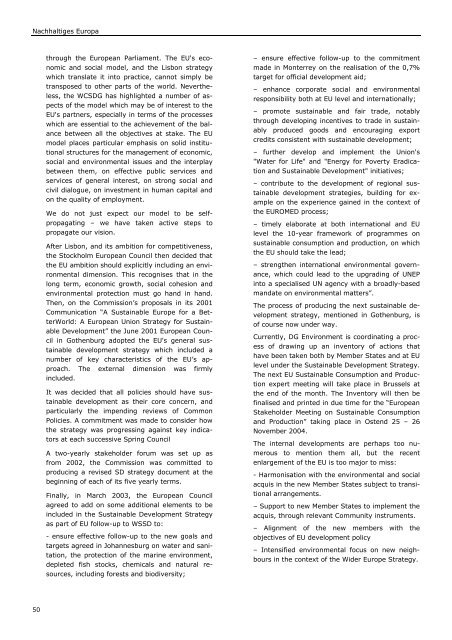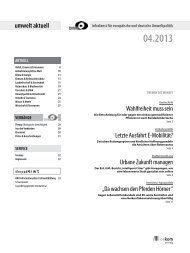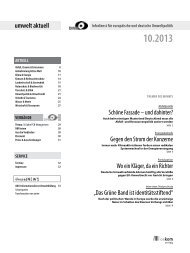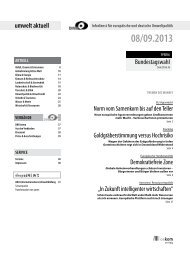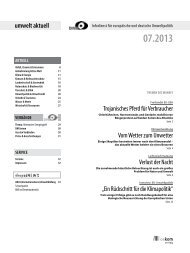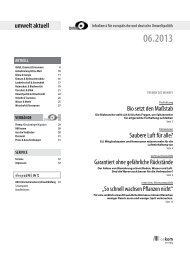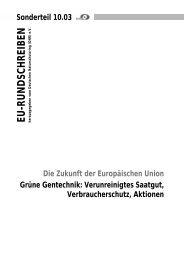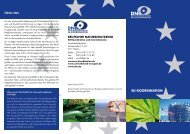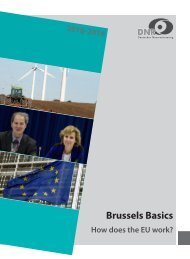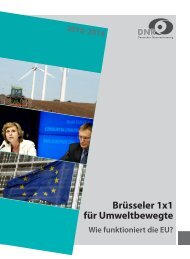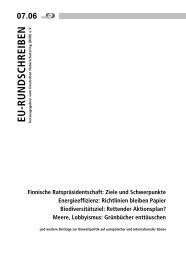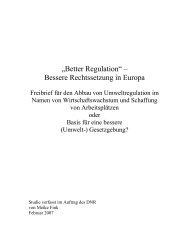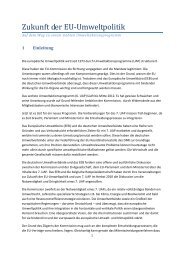Nachhaltiges Europa Abschlusspublikation - Global Marshall Plan
Nachhaltiges Europa Abschlusspublikation - Global Marshall Plan
Nachhaltiges Europa Abschlusspublikation - Global Marshall Plan
Erfolgreiche ePaper selbst erstellen
Machen Sie aus Ihren PDF Publikationen ein blätterbares Flipbook mit unserer einzigartigen Google optimierten e-Paper Software.
<strong>Nachhaltiges</strong> <strong>Europa</strong><br />
50<br />
through the European Parliament. The EU's eco-<br />
nomic and social model, and the Lisbon strategy<br />
which translate it into practice, cannot simply be<br />
transposed to other parts of the world. Neverthe-<br />
less, the WCSDG has highlighted a number of aspects<br />
of the model which may be of interest to the<br />
EU's partners, especially in terms of the processes<br />
which are essential to the achievement of the balance<br />
between all the objectives at stake. The EU<br />
model places particular emphasis on solid institutional<br />
structures for the management of economic,<br />
social and environmental issues and the interplay<br />
between them, on effective public services and<br />
services of general interest, on strong social and<br />
civil dialogue, on investment in human capital and<br />
on the quality of employment.<br />
We do not just expect our model to be self-<br />
propagating – we have taken active steps to<br />
propagate our vision.<br />
After Lisbon, and its ambition for competitiveness,<br />
the Stockholm European Council then decided that<br />
the EU ambition should explicitly including an environmental<br />
dimension. This recognises that in the<br />
long term, economic growth, social cohesion and<br />
environmental protection must go hand in hand.<br />
Then, on the Commission’s proposals in its 2001<br />
Communication “A Sustainable Europe for a Bet-<br />
terWorld: A European Union Strategy for Sustainable<br />
Development” the June 2001 European Council<br />
in Gothenburg adopted the EU's general sus-<br />
tainable development strategy which included a<br />
number of key characteristics of the EU’s approach.<br />
The external dimension was firmly<br />
included.<br />
It was decided that all policies should have sustainable<br />
development as their core concern, and<br />
particularly the impending reviews of Common<br />
Policies. A commitment was made to consider how<br />
the strategy was progressing against key indicators<br />
at each successive Spring Council<br />
A two-yearly stakeholder forum was set up as<br />
from 2002, the Commission was committed to<br />
producing a revised SD strategy document at the<br />
beginning of each of its five yearly terms.<br />
Finally, in March 2003, the European Council<br />
agreed to add on some additional elements to be<br />
included in the Sustainable Development Strategy<br />
as part of EU follow-up to WSSD to:<br />
- ensure effective follow-up to the new goals and<br />
targets agreed in Johannesburg on water and sanitation,<br />
the protection of the marine environment,<br />
depleted fish stocks, chemicals and natural re-<br />
sources, including forests and biodiversity;<br />
– ensure effective follow-up to the commitment<br />
made in Monterrey on the realisation of the 0,7%<br />
target for official development aid;<br />
– enhance corporate social and environmental<br />
responsibility both at EU level and internationally;<br />
– promote sustainable and fair trade, notably<br />
through developing incentives to trade in sustainably<br />
produced goods and encouraging export<br />
credits consistent with sustainable development;<br />
– further develop and implement the Union's<br />
"Water for Life" and "Energy for Poverty Eradica-<br />
tion and Sustainable Development" initiatives;<br />
– contribute to the development of regional sus-<br />
tainable development strategies, building for example<br />
on the experience gained in the context of<br />
the EUROMED process;<br />
– timely elaborate at both international and EU<br />
level the 10-year framework of programmes on<br />
sustainable consumption and production, on which<br />
the EU should take the lead;<br />
– strengthen international environmental govern-<br />
ance, which could lead to the upgrading of UNEP<br />
into a specialised UN agency with a broadly-based<br />
mandate on environmental matters”.<br />
The process of producing the next sustainable development<br />
strategy, mentioned in Gothenburg, is<br />
of course now under way.<br />
Currently, DG Environment is coordinating a proc-<br />
ess of drawing up an inventory of actions that<br />
have been taken both by Member States and at EU<br />
level under the Sustainable Development Strategy.<br />
The next EU Sustainable Consumption and Production<br />
expert meeting will take place in Brussels at<br />
the end of the month. The Inventory will then be<br />
finalised and printed in due time for the “European<br />
Stakeholder Meeting on Sustainable Consumption<br />
and Production” taking place in Ostend 25 – 26<br />
November 2004.<br />
The internal developments are perhaps too numerous<br />
to mention them all, but the recent<br />
enlargement of the EU is too major to miss:<br />
- Harmonisation with the environmental and social<br />
acquis in the new Member States subject to transitional<br />
arrangements.<br />
– Support to new Member States to implement the<br />
acquis, through relevant Community instruments.<br />
– Alignment of the new members with the<br />
objectives of EU development policy<br />
– Intensified environmental focus on new neigh-<br />
bours in the context of the Wider Europe Strategy.


